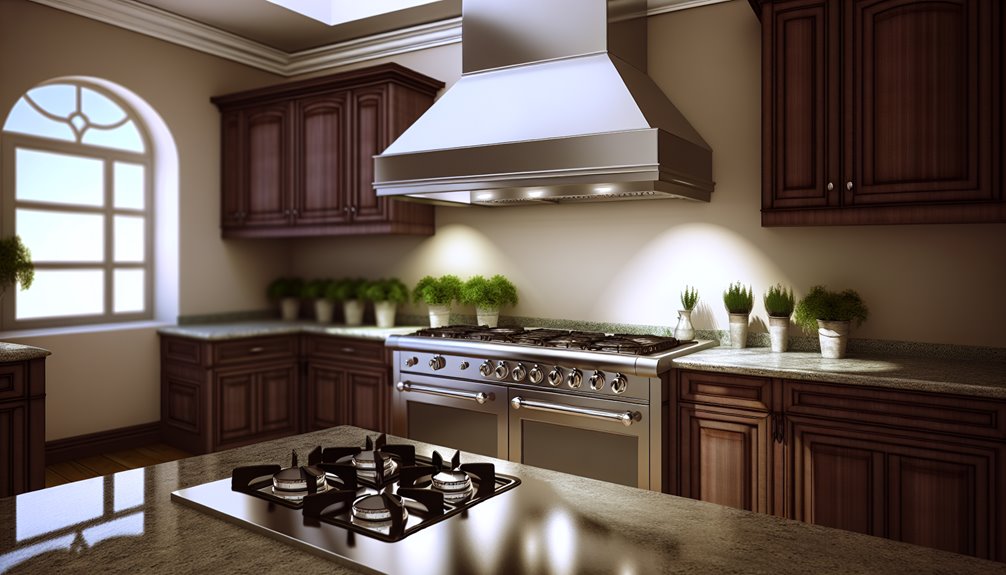The best place to put your gas stove is near prep areas, ensuring easy access to ingredients and utensils. Keep it away from high-traffic zones to prevent accidents and maintain clear pathways. Don’t forget ventilation—install a range hood for effective air quality management. Also, check the distance from flammable materials and consider proximity to the sink for easier cleanup. For more insights on optimizing your kitchen layout and enhancing cooking efficiency, consider exploring further.
Key Takeaways
- Position the gas stove near prep areas to streamline workflow and enhance cooking efficiency.
- Ensure proper ventilation with a suitable range hood to remove harmful gases and odors.
- Maintain a safe distance from flammable materials to minimize fire hazards and ensure safety.
- Keep the stove away from high-traffic zones to reduce the risk of accidents during cooking.
- Allow ample space around the stove for easy access, maintenance, and safe operation.
Importance of Gas Stove Placement
When you’re designing your kitchen, the placement of your gas stove is crucial, as it can greatly impact both safety and functionality. Choosing a location that allows for easy access while cooking enhances your overall cooking experience.
You’ll want to take into account the aesthetic appeal, too; a well-placed stove can serve as a focal point in your kitchen design. Additionally, think about maintenance ease. Keeping the stove close to your sink can simplify cleanup, making it easier to manage spills and splatters.
Make certain there’s ample counter space nearby for food prep, which adds to both efficiency and safety. Ultimately, a thoughtful stove placement not only improves your cooking environment but also contributes to the overall harmony of your kitchen design.
Ventilation Considerations
Proper ventilation plays a key role in your kitchen design, especially when positioning your gas stove. You want to guarantee that harmful gases and odors are efficiently removed.
There are several ventilation types to contemplate, including range hoods, downdraft systems, and wall-mounted units. Each serves to improve air quality by filtering out smoke, grease, and other pollutants.
When selecting the right ventilation type, think about the layout of your kitchen and how it affects airflow. A well-placed range hood can greatly enhance your cooking experience, keeping your kitchen fresh and inviting.
Proximity to Prep Areas
When setting up your kitchen, consider placing the gas stove close to your prep areas for maximum cooking zone efficiency.
This layout streamlines your workflow, making it easier to shift from chopping to cooking without wasting time. A well-planned proximity not only enhances your cooking experience but also keeps everything organized.
Cooking Zone Efficiency
To guarantee smooth cooking experiences, placing your gas stove close to prep areas is essential. When your stove is nearby, you can easily shift from chopping vegetables to sautéing them, making your cooking techniques more efficient.
Good kitchen organization plays an important role here; keep utensils, cutting boards, and ingredients within arm’s reach. This setup minimizes unnecessary movement, allowing you to focus on the task at hand rather than running back and forth.
A well-placed gas stove not only enhances your cooking efficiency but also encourages creativity in the kitchen. By prioritizing proximity to prep areas, you’ll find that your cooking sessions become more enjoyable and productive, ultimately leading to better meals and a more satisfying cooking experience.
Workflow Optimization
Optimizing your kitchen workflow hinges on strategically placing your gas stove in relation to prep areas. To enhance efficiency, consider your workflow strategies. The stove should be within arm’s reach of your cutting board and prep space. This arrangement minimizes unnecessary steps, allowing you to shift seamlessly between chopping, sautéing, and cooking.
Incorporating kitchen ergonomics is essential; the height of your stove should be comfortable for you to use without straining.
When planning your layout, think about the triangle formed between your stove, sink, and refrigerator. Keeping these elements close together promotes a seamless cooking experience, reducing time spent moving around.
With thoughtful placement, you’ll create a kitchen that not only looks good but also works efficiently.
Traffic Flow and Accessibility
Although a well-placed gas stove enhances your cooking experience, guaranteeing proper traffic flow and accessibility in the kitchen is equally important.
You want to create a seamless cooking environment that prioritizes kitchen ergonomics and gas line accessibility. Consider these key factors:
- Placement: Position the stove near prep areas but away from high-traffic zones.
- Clear Pathways: Ascertain there’s enough space for movement around the stove, allowing you to cook without interruptions.
- Accessibility: Make sure the gas line is easily reachable for maintenance and safety checks.
Safety Guidelines for Gas Stove Location
When choosing a location for your gas stove, safety should be your top priority. First, verify it’s away from flammable materials like curtains or paper towels to minimize fire hazards.
Position your stove in a well-ventilated area to help dissipate any potential gas leaks quickly. It’s also essential to avoid placing it near high-traffic zones, reducing the risk of accidental bumps.
Make sure there’s enough space around the stove for easy access to the controls and any necessary maintenance.
Finally, consider installing a gas leak detector nearby for added peace of mind.
Ideal Kitchen Layouts for Gas Stoves
Choosing the right kitchen layout for your gas stove can considerably enhance your cooking experience. Effective kitchen design guarantees seamless appliance integration, allowing you to cook efficiently and comfortably.
Here are three ideal layouts to contemplate:
- L-Shaped Kitchen: Provides ample counter space and keeps the stove easily accessible while maintaining a clear workflow.
- U-Shaped Kitchen: Offers more storage and work surfaces, creating a functional triangle between the stove, fridge, and sink for efficient cooking.
- Galley Kitchen: Maximizes space in smaller areas, allowing for easy movement between the stove and other appliances without obstruction.
Impact on Cooking Efficiency
The layout of your kitchen greatly influences your cooking efficiency. A well-placed gas stove enhances cooking speed and guarantees even heat distribution. When considering placement, think about how close your stove is to prep areas and appliances. Here’s a quick overview of factors affecting your cooking efficiency:
| Factor | Impact on Cooking Speed | Importance of Heat Distribution |
|---|---|---|
| Stove Placement | Directly affects times | Guarantees food cooks evenly |
| Proximity to Work Areas | Reduces movement time | Improves overall cooking results |
| Ventilation | Impacts air quality | Affects cooking comfort |
Final Thoughts on Gas Stove Placement
While finding the perfect spot for your gas stove may seem challenging, considering your kitchen’s flow and functionality can make the decision easier.
Placing your gas stove thoughtfully enhances both cooking efficiency and the overall kitchen ambiance. Here are a few key points to keep in mind:
- Confirm it’s near prep areas for easy access to ingredients.
- Consider its placement relative to other appliances for a seamless workflow.
- Think about gas stove aesthetics; a well-placed stove can elevate your kitchen’s design.
Ultimately, by balancing functionality with style, you’ll create a welcoming space that complements your cooking habits.
Frequently Asked Questions
Can I Place a Gas Stove Near a Refrigerator?
When it comes to gas stove placement, you’ve gotta play it safe. Placing a gas stove near a refrigerator isn’t ideal; it can cause efficiency issues and potential hazards. Keep your kitchen safety a top priority!
What Materials Are Best for a Kitchen Countertop Near a Gas Stove?
When choosing countertop materials near a gas stove, you’ll want heat resistance. Options like granite, quartz, and stainless steel work well, ensuring your surfaces withstand high temperatures while maintaining durability and aesthetic appeal in your kitchen.
Is There a Minimum Distance From a Gas Stove to a Sink?
You should maintain at least 24 inches between your gas stove and sink for safety reasons. This distance helps prevent accidents and allows for an efficient kitchen layout, ensuring you cook safely and comfortably.
How Do I Clean Around a Gas Stove Safely?
Did you know 70% of kitchen accidents involve cleaning mishaps? To clean around your gas stove safely, use gentle cleaning solutions, wear gloves, and follow safety precautions like turning off the gas and ensuring proper ventilation.
Can I Install a Gas Stove in a Corner Kitchen?
You can install a gas stove in a corner kitchen, but guarantee proper corner installation and meet ventilation requirements. Adequate airflow is vital for safety and efficiency, so don’t overlook this critical aspect.



